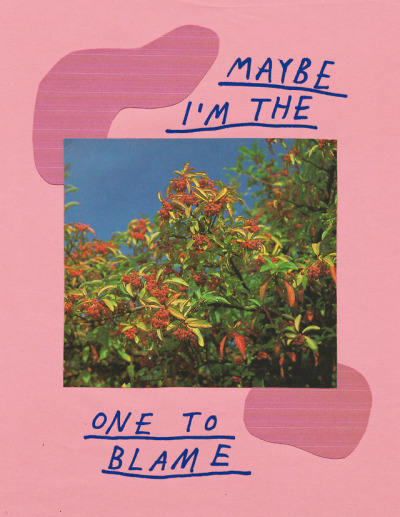Here, we explore issues, events, and developments in one of the major concerns in modern archaeology—the repatriation of stolen artifacts. A limited-series podcast is coming soon.
Don't wanna be here? Send us removal request.
Photo






some notes on loving a little too hard, a little too heavy
richard siken // ( x ) // ray bradbury // ( x ) // richard siken // ( x )
12K notes
·
View notes
Text
“I hunt the wilderness in myself”
— Vanessa Angélica Villarreal, from “Malinche,” Beast Meridian (via lifeinpoetry)
3K notes
·
View notes
Photo

Pink Floyd’s The Dark Side Of The Moon 1973
5K notes
·
View notes
Text
Nefertiti's Bust

Photo from here
(word count: 385 / class term: SAA Principles of Archaeological Ethics)
Nefertiti's Bust has created a long-standing rift between Egypt and Germany, with the bust currently being held by the latter nation in Berlin’s Neues Museum, and having been in the country for more than 100 years. 1 The issues with Nefertiti’s Bust began following its excavation by a team of German archaeologists led by Ludwig Borchardt in 1912. 2 At the time the English protectorate of Egypt allowed non-egyptian excavators to retain a share of their findings, with the rest remaining in Egypt to preserve any unique or important artifacts while still encouraging legal excavations. 3 When Borchardt submitted lists for inspection the bust was left off the list and its box was not opened by officials so the massive bust managed to be smuggled out of the country without notice. 4 It was first displayed in 1923, and in the years following Egypt has attempted numerous times to have the bust returned to them. Adolf Hitler refused in 1933, the Allied Control Council refused in 1946, and Germany refused again in 2011 following a series of campaigns led by Zahi Hawass, the then-secretary-general of the Supreme Council of Antiquities in Egypt. 5
2020 saw a resurgence in Egyptian efforts demanding the return of Nefertiti among other artifacts, citing the deceitful division process that occurred, while Germany disputes this. 6 Egyptian officials have stated that the nation “would not cede its right to reclaim Nefertiti's bust” while German officials consider the piece a component of the “shared history” between the nations and is working on exhibitions and projects with Egyptian museums and ministries. 7 The arguments here and the repeated conflicts over this bust are a perfect microcosm of the reality of many repatriation efforts, displaying how these discussions occur and what the arguments of the opposing nations are and what they represent. For Germany, this piece is a priceless artifact and a massive draw for visitors ($$$), and allegedly cannot be safely stored in Egypt. For Egypt, it is a piece of cultural history, an ancient part of the land. This has made me think of the Nine Principles of Archaeological Ethics outlined by the Society of American Archaeologists, which emphasize outreach to marginalized groups, multivocality, respect, and ensuring that stewardship of artifacts is dictated by the descendants of the people they belonged to. 8
Tyldesley, Joyce. “How Nefertiti's Bust Ended up in Germany.” Australian Financial Review, February 23, 2018. https://www.afr.com/life-and-luxury/arts-and-culture/how-nefertitis-bust-ended-up-in-germany-20180220-h0wdyb.
Ibid.
Ibid.
Ayyad, Ibrahim. “Egypt Renews Demands to Retrieve Nefertiti Bust from Germany.” Al Monitor, October 1, 2020. https://www.al-monitor.com/originals/2020/10/egypt-germany-nefertiti-bust-claim-stolen-antiquities.html.
Ibid.
Ibid.
Ibid.
“Ethics in Professional Archaeology.” Society for American Archaeology. Accessed August 16, 2022. https://www.saa.org/career-practice/ethics-in-professional-archaeology.
0 notes
Text
The Case of the British Museum

Photo from here
(word count: 747 / class term: deaccessioning)
I don’t know about you, reader, but I’ve heard my fair share of funny comments along the lines of, “If the British Museum gave back everything it stole, the whole building would be empty!” This sounds like an exaggeration, but it’s not far from the truth—according to human rights lawyer Geoffrey QC, “The British Museum is the world’s largest receiver of stolen property.” The institution constantly fields requests to return objects, and denies nearly all of them, except in special cases. 1 It holds over 8 million objects, of which about 80,000 are permanently displayed, and many are from Egypt. High-profile ones include the Rosetta Stone and the Elgin Marbles; the return of both has been requested by Egypt and Greece, respectively. 2
However, even if the museum wanted to engage in genuine repatriation, the process is not simple. The British Museum’s rules regarding disposal of any items were defined in the British Museum Act of 1963, subsection 5.1. 3 In it there are 4 specific situations outlined in which removal of an object is allowed: an object is a duplicate of another, an object was made after 1850 and can be reproduced from photographs (or something akin to photographs), and if the board of Trustees determines that it is unfit for collection and of no use to students. 4 There are subsections dealing with objects that are infested or damaged, or for loaning artifacts out to other institutions, and these are the only situations in which an artifact can be permanently taken out of the collection. 5 In other words, deaccessioning, or the process of removing an artifact from a repository, is strictly regulated, and is solely the decision of the Board of Trustees, which is appointed by the British government to undeniably advance British interests. 6 Without legislative changes, the battle for repatriation faces serious institutional hurdles. Truthfully, it appears that they are more likely institutional impossibilities, so long as Britain desperately wants to cling to the power of its colonial heyday, which was abundantly clear to me during my summer spent there. Nationalism, royalism, and the obfuscation of the truth about the colonial empire are British cultural values.
“The Museum understands and recognises the significance of the issues surrounding the return of objects and works with communities, colleagues and museums across the globe to share the collection as widely as possible. We believe in the importance of lending our collection, it strengthens the stories the collection tells and when displayed alongside other objects, they create new stories and conversations.” 7
This was the most recent statement from a spokesperson for the British Museum after it was announced that several pieces associated with the Benin Kingdom were going to be loaned to Nigeria, following a series of protests as well as announcements from other museums that their pieces were going to be returned. 8 This stance, while consistent with the current state of the law, plainly shows the attitude the British Museum holds towards the idea of repatriation. At another point the spokesman refers to the artifacts from Benin as pieces of the “permanent collection,” indicating that while they might allow artifacts to be displayed in the lands they originate from, they have no doubt about who owns them. 9 As of now, the British Museum is happy to work within the confines of the law and to enforce their dominion over the countless artifacts which have been torn from the people that created them.
Other museums in the United Kingdom, however, have been engaging in repatriation efforts. One is the Pitt Rivers Museum, which was once dubbed “one of the most violent spaces in Oxford.10 After Samwel Nangiria, a scientist and representative of the Maasai tribe, confronted the museum about egregious errors in the museum’s display of Maasai artifacts, the museum created a program called the Living Cultures initiative. 11 This is a partnership between Maasai representatives in Kenya and Tanzania, the museum, and a non-profit that advocates for indigenous voices, and it allows them to serve as direct consultants and provide guidance and information valuable to tracing provenance. 12 It allows for the Maasai community to have a say in whether an artifact needs reinterpretation, a change in the way it’s displayed, or repatriation altogether. 13
Other European countries like France have also begun a repatriation process, as last November Emmanuel Macron would return objects that were taken from their colonies in Africa. Let’s see how slowly it goes. 14
Alberge, Dalya. “British Museum Is World's Largest Receiver of Stolen Goods, Says QC.” The Guardian. Guardian News and Media, November 4, 2019. https://www.theguardian.com/world/2019/nov/04/british-museum-is-worlds-largest-receiver-of-stolen-goods-says-qc.
Ahmadi, Ali Abbas. “Should the British Museum Return Its Egyptian Collection?” The New Arab. The New Arab, December 13, 2019. https://english.alaraby.co.uk/analysis/should-british-museum-return-its-egyptian-collection.
“Annex III: Position Statement on Duties, Powers, Policies and Procedures in Relation to Restitution, Repatriation and Spoliation .” House of Commons. Parliament. Accessed August 18, 2022. https://publications.parliament.uk/pa/cm199900/cmselect/cmcumeds/371/0060805.htm.
Ibid.
Ibid.
Sánchez-Morales, Lara. “Laboratory & Curation in Archaeology.” Zoom, University of Texas at Austin, July 21, 2018.
Fleary, Sinai. “Looted Benin Bronzes Can Be ‘Loaned’ Says British Museum.” Voice Online, March 3, 2022. https://www.voice-online.co.uk/news/uk-news/2022/03/03/looted-benin-bronzes-can-be-loaned-says-british-museum/.
Ibid.
Ibid.
Adams, Geraldine Kendall. “A New Approach to Repatriation.” Museums Association, December 11, 2020. https://www.museumsassociation.org/museums-journal/features/2020/11/a-new-approach-to-repatriation/.
Ibid.
Ibid.
Ibid.
Porterfield, Carlie. “Europe's Museums, Collectors Are Returning Artifacts to Countries of Origin amid Fresh Scrutiny.” Forbes. Forbes Magazine, April 21, 2022. https://www.forbes.com/sites/carlieporterfield/2021/10/27/europes-museums-collectors-are-returning-artifacts-to-countries-of-origin-amid-fresh-scrutiny/?sh=16ceceaf675b.
0 notes
Text
What Is Repatriation?
(word count: 624 / class terms: provenance, Ethics of Conservation, and Native American Graves Protection and Repatriation Act)
“Decolonization is not a metaphor.” This phrase, the title and primary theme of a deeply powerful piece by Indigenous Studies scholars Eve Tuck and K. Wayne Yang, succinctly summarizes the following truth: decolonization, or the undoing of colonialism and its violent legacies, can only be achieved through tangible means, such as the return of land, objects of meaning, and political and economic power to colonized peoples. 1

Photo from here
Repatriation is the return of objects, artifacts, and belongings to the homeland, group, or people from which they were taken, or stolen.2 Inextricable from legacies of colonialism, the repatriation movement ranges from formal requests from one country to another, to guerrilla, activist-led tours of institutions like the British Museum, or to protests inside the Brooklyn Museum. 3
And yet, things are complicated. The actual process of repatriation in today’s world order is complex, mired in the limitations of national and international law, conflicting cultural and political interests, and the efforts of (both former and current) colonizing nations to hold onto the spoils of dominance (and exploitation). International law does not compel the return of looted artifacts. 4 The seemingly insurmountable bureaucratic hoops that must be jumped through in order to even begin the process of repatriation are also a deterrent. Sometimes objects lack clear provenance, or the comprehensive available documented history of an artifact’s journey from place to place, which makes it difficult to know to whom to return an object. 5 This makes me think about how much is lost over time, about what we cannot possibly know, about what is up to us to interpret.
Sure, there is also the fact that sometimes, the original owners or stewards of artifacts sometimes do not want them back for different reasons. Some prefer just providing guidance or consulting on how something is displayed. 6 However, the key here is that these groups were given the chance to voice whether or not they wanted the artifacts to be returned to them. Repatriation is complicated (of course, made so by institutional barriers and the legacy of empire), and to me, it seems that the only real blanket statement that can be made about it is that the outcome or choices made should reflect the wishes of the group, individual, or government from which an object was taken. Not doing so violates the Ethics of Conservation, of which the fourth step is “Collaboration,” or seeking the input of all necessary parties that are required to ensure the highest quality of preservation. 7
In America, issues in repatriation largely center around Native American groups and their artifacts (and of course, land). Native American Graves Protection and Repatriation Act of 1990, which recognizes the right of tribes to have their human remains, funerary objects, sacred objects, and objects of cultural patrimony removed from federal lands and federally funded agencies and museums. 8 It seeks to to return, protect, and prevent trafficking of Native American objects. 9 However, proving tribal ancestry in the eyes of and meeting all the requirements of the US government is a purposefully difficult process that is often too painful for descendants.10 However, like all of these issues, where one tribe might want one thing, another tribe might want something else. For many tribes, repatriation is a healing process. 11
It’s important to talk about complications and obstacles when talking about an issue, but despite the complications I have talked about, the issue of decolonization and repatriation is quite clear-cut to me. It goes back to the sort of blanket statement that in each and every case in which repatriation is being debated, the wishes of the living descendants of the makers of the artifact should be respected, and too often, their wishes are actually ignored or dismissed.
Tuck, Eve, and K. Wayne Yang. “Decolonization Is Not a Metaphor.” Decolonization: Indigeneity, Education & Society 1, no. 1 (2012): 1–40. https://jps.library.utoronto.ca/index.php/des/article/view/18630
Ghoshray, Saby. “Repatriation of the Kohinoor Diamond: Expanding the Legal Paradigm for Cultural Heritage.” Fordham International Law Journal, 6, 31, no. 3 (2007). https://ir.lawnet.fordham.edu/cgi/viewcontent.cgi?referer=https://www.google.com/&httpsredir=1&article=2098&conte
Polonsky, Naomi. “Hundreds Attend Guerrilla, Activist-Led Tour of Looted Artifacts at the British Museum.” Hyperallergic, December 18, 2018. https://hyperallergic.com/475256/hundreds-attend-guerilla-activist-led-tour-of-looted-artifacts-at-the-british-museum/?fbclid=IwAR0lqpgP1Ji_XJqMhCR0CJ-LY7ZcoLcWwlP-1ATi7u5--mQT4H4XAOAHlmA & Greenberger, Alex. “'Brooklyn Is Not for Sale': Decolonize This Place Leads Protest at Brooklyn Museum.” ARTnews.com. ARTnews.com, November 18, 2019. https://www.artnews.com/art-news/news/brooklyn-not-sale-decolonize-place-leads-protest-brooklyn-museum-10230/.
Ghoshray, Saby. “Repatriation of the Kohinoor Diamond: Expanding the Legal Paradigm for Cultural Heritage.” Fordham International Law Journal, 6, 31, no. 3 (2007). https://ir.lawnet.fordham.edu/cgi/viewcontent.cgi?referer=https://www.google.com/&httpsredir=1&article=2098&conte.
Sánchez-Morales, Lara. “Laboratory & Curation in Archaeology.” Zoom, University of Texas at Austin, July 21, 2018.
Adams, Geraldine Kendall. “A New Approach to Repatriation.” Museums Association, December 11, 2020. https://www.museumsassociation.org/museums-journal/features/2020/11/a-new-approach-to-repatriation/.
Sánchez-Morales, Lara. “Laboratory & Curation in Archaeology.” Zoom, University of Texas at Austin, July 21, 2018.
Sánchez-Morales, Lara. “The Profession of Archaeology.” Zoom, University of Texas at Austin, July 13, 2018.
“Native American Graves Protection and Repatriation Act (U.S. National Park Service).” National Parks Service. U.S. Department of the Interior. Accessed August 17, 2022. https://www.nps.gov/subjects/nagpra/index.htm.
Sánchez-Morales, Lara. “The Profession of Archaeology.” Zoom, University of Texas at Austin, July 13, 2018.
Killion, Thomas W. Opening Archaeology: Repatriation's Impact on Contemporary Research and Practice. Santa Fe, NM: School for Advanced Research Press, 2008.
1 note
·
View note
Text
Works Cited
Adams, Geraldine Kendall. “A New Approach to Repatriation.” Museums Association, December 11, 2020. https://www.museumsassociation.org/museums-journal/features/2020/11/a-new-approach-to-repatriation/.
Ahmadi, Ali Abbas. “Should the British Museum Return Its Egyptian Collection?” The New Arab. The New Arab, December 13, 2019. https://english.alaraby.co.uk/analysis/should-british-museum-return-its-egyptian-collection.
Alberge, Dalya. “British Museum Is World's Largest Receiver of Stolen Goods, Says QC.” The Guardian. Guardian News and Media, November 4, 2019. https://www.theguardian.com/world/2019/nov/04/british-museum-is-worlds-largest-receiver-of-stolen-goods-says-qc.
“Annex III: Position Statement on Duties, Powers, Policies and Procedures in Relation to Restitution, Repatriation and Spoliation .” House of Commons. Parliament. Accessed August 18, 2022. https://publications.parliament.uk/pa/cm199900/cmselect/cmcumeds/371/0060805.htm.
Ayyad, Ibrahim. “Egypt Renews Demands to Retrieve Nefertiti Bust from Germany.” Al Monitor, October 1, 2020. https://www.al-monitor.com/originals/2020/10/egypt-germany-nefertiti-bust-claim-stolen-antiquities.html.
Fleary, Sinai. “Looted Benin Bronzes Can Be ‘Loaned’ Says British Museum.” Voice Online, March 3, 2022. https://www.voice-online.co.uk/news/uk-news/2022/03/03/looted-benin-bronzes-can-be-loaned-says-british-museum/.
Ghoshray, Saby. “Repatriation of the Kohinoor Diamond: Expanding the Legal Paradigm for Cultural Heritage.” Fordham International Law Journal, 6, 31, no. 3 (2007). https://ir.lawnet.fordham.edu/cgi/viewcontent.cgi?referer=https://www.google.com/&httpsredir=1&article=2098&cont.
Greenberger, Alex. “'Brooklyn Is Not for Sale': Decolonize This Place Leads Protest at Brooklyn Museum.” ARTnews.com. ARTnews.com, November 18, 2019. https://www.artnews.com/art-news/news/brooklyn-not-sale-decolonize-place-leads-protest-brooklyn-museum-10230/.
Killion, Thomas W. Opening Archaeology: Repatriation's Impact on Contemporary Research and Practice. Santa Fe, NM: School for Advanced Research Press, 2008.
Lonetree, Amy. Decolonizing Museums: Representing Native America in National and Tribal Museums. University of North Carolina Press, 2012. JSTOR, http://www.jstor.org/stable/10.5149/9780807837528_lonetree. Accessed 16 Aug. 2022.
Marcelo, Philip. “Return of Wounded Knee Artifacts Spotlights Slow Repatriation Pace for Native Americans.” USA Today. Gannett Satellite Information Network, July 30, 2022. https://www.usatoday.com/story/news/nation/2022/07/30/native-american-wounded-knee-artifacts-repatriation/10191921002/.
“Native American Graves Protection and Repatriation Act (U.S. National Park Service).” National Parks Service. U.S. Department of the Interior. Accessed August 17, 2022. https://www.nps.gov/subjects/nagpra/index.htm.
Polonsky, Naomi. “Hundreds Attend Guerrilla, Activist-Led Tour of Looted Artifacts at the British Museum.” Hyperallergic, December 18, 2018. https://hyperallergic.com/475256/hundreds-attend-guerilla-activist-led-tour-of-looted-artifacts-at-the-british-museum/?fbclid=IwAR0lqpgP1Ji_XJqMhCR0CJ-LY7ZcoLcWwlP-1ATi7u5--mQT4H4XAOAHlmA.
Porterfield, Carlie. “Europe's Museums, Collectors Are Returning Artifacts to Countries of Origin amid Fresh Scrutiny.” Forbes. Forbes Magazine, April 21, 2022. https://www.forbes.com/sites/carlieporterfield/2021/10/27/europes-museums-collectors-are-returning-artifacts-to-countries-of-origin-amid-fresh-scrutiny/?sh=16ceceaf675b.
Sánchez-Morales, Lara. “Laboratory & Curation in Archaeology.” Zoom, University of Texas at Austin, July 21, 2018.
Sánchez-Morales, Lara. “The Profession of Archaeology.” Zoom, University of Texas at Austin, July 13, 2018.
Tuck, Eve, and K. Wayne Yang. “Decolonization Is Not a Metaphor.” Decolonization: Indigeneity, Education & Society 1, no. 1 (2012): 1–40. https://jps.library.utoronto.ca/index.php/des/article/view/18630.
1 note
·
View note

